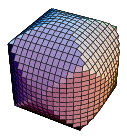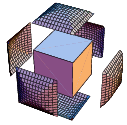Revision history [back]
First of all. Excellent question. Getting started on this took three students, four websites, a physics professor, and a visit to the math lab. I'm still not sure if I'm right and there are some things you'll have to take at face value but I have an answer.
So according to the internet, the shape this forms is called a steinmetz solid, the three cylinder steinmetz solid happens to be something called a "Rhombic Dodecahedron" (seen below).

This is kind of like the shape you would get if you tried to make a rubber band ball around a cube, or the one I ended up thinking of it as; "Cube with square shaped yamikas on all sides."

Images courtesy of Wolfram Mathworld
The radius of the cylinders through this cube is 1 so a side length is 2. Thus the volume of the cube section is 8.
Next we add the volumes of the six "square yamikas".
I am totally unable to come up with a way of doing this but Wolfram has a method of parametrizing the surface area and apparently then does an iterated integral of the parametrized surface area from $-r$ to $r$ or $-1$ to $1$ in our case. And from $0$ to $\frac{\pi}{4}$. So they're finding one fourth of the volume of a yamika.
Their formula (the derivation of which is not explained) implies our problem should look something like this. $$8+\int_{0}^{\frac{\pi}{4}} \int_{-r}^{r} (2(r^{2}-z^{2})^{\frac{1}{2}})dz$$
I don't understand their parametrization at all but if this can get anyone better than me started on this then I would greatly appreciate an explanation to this too.
Mathworld really did seem to be the best resource on this even though it's really not a ton of help.
 | 2 | No.2 Revision |
First of all. Excellent question. Getting started on this took three students, four websites, a physics professor, and a visit to the math lab. I'm still not sure if I'm right and there are some things you'll have to take at face value but I have an answer.
So according to the internet, the shape this forms is called a steinmetz solid, the three cylinder steinmetz solid happens to be something called a "Rhombic Dodecahedron" (seen below).

This is kind of like the shape you would get if you tried to make a rubber band ball around a cube, or the one I ended up thinking of it as; "Cube with square shaped yamikas on all sides."

Images courtesy of Wolfram Mathworld
The radius of the cylinders through this cube is 1 so a side length is 2. Thus the volume of the cube section is 8.
Next we add the volumes of the six "square yamikas".
I am totally unable to come up with a way of doing this but Wolfram has a method of parametrizing the surface area and apparently then does an iterated integral of the parametrized surface area from $-r$ to $r$ or $-1$ to $1$ in our case. And from $0$ to $\frac{\pi}{4}$. So they're finding one fourth of the volume of a yamika.
Their formula (the derivation of which is not explained) implies our problem should look something like this.
$$8+\int_{0}^{\frac{\pi}{4}} $$8+6 \int_{0}^{\frac{\pi}{4}} \int_{-r}^{r} (2(r^{2}-z^{2})^{\frac{1}{2}})dz$$
I don't understand their parametrization at all but if this can get anyone better than me started on this then I would greatly appreciate an explanation to this too.
Mathworld really did seem to be the best resource on this even though it's really not a ton of help.
 | 3 | No.3 Revision |
First of all. Excellent question. Getting started on this took three students, four websites, a physics professor, and a visit to the math lab. I'm still not sure if I'm right and there are some things you'll have to take at face value but I have an answer. a way to get things moving a little bit.
So according to the internet, the shape this forms is called a steinmetz solid, the three cylinder steinmetz solid happens to be something called a "Rhombic Dodecahedron" (seen below).

This is kind of like the shape you would get if you tried to make a rubber band ball around a cube, or the one I ended up thinking of it as; "Cube with square shaped yamikas on all sides."

Images courtesy of Wolfram Mathworld
The radius of the cylinders through this cube is 1 so a side length is 2. Thus the volume of the cube section is 8.
Next we add the volumes of the six "square yamikas".
I am totally unable to come up with a way of doing this but Wolfram has a method of parametrizing the surface area and apparently then does an iterated integral of the parametrized surface area from $-r$ to $r$ or $-1$ to $1$ in our case. And from $0$ to $\frac{\pi}{4}$. So they're finding one fourth of the volume of a yamika.
Their formula (the derivation of which is not explained) implies our problem should look something like this. $$8+6 \int_{0}^{\frac{\pi}{4}} \int_{-r}^{r} (2(r^{2}-z^{2})^{\frac{1}{2}})dz$$
I don't understand their parametrization at all but if this can get anyone better than me started on this then I would greatly appreciate an explanation to this too.
Mathworld really did seem to be the best resource on this even though it's really not a ton of help.
